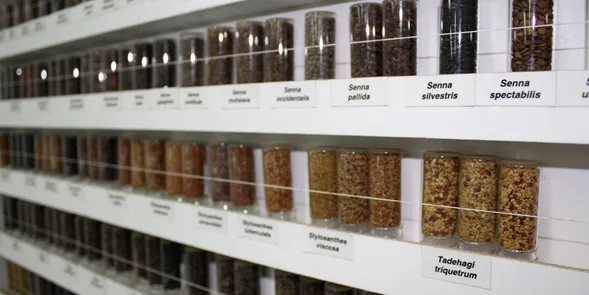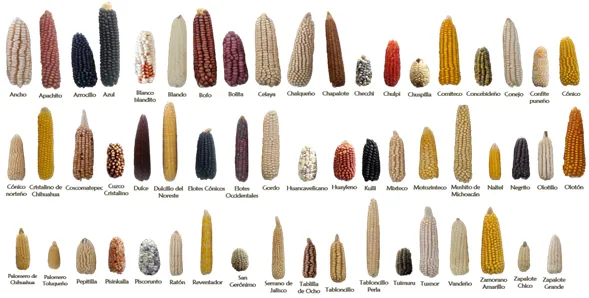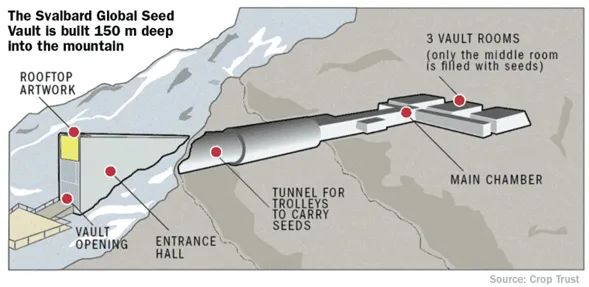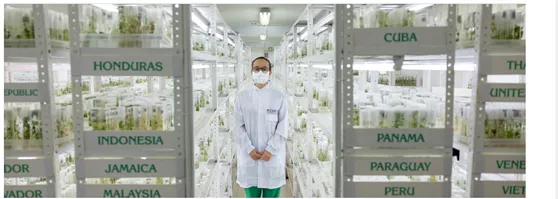Through rainforests and arid plains, in the quiet of a bunker that can protect against a nuclear attack in the arctic, or in the middle of the war zone that became Aleppo, scientists work to preserve the food future of humanity, protecting with their lives seed collections.

Hello ecotrain friends, I hope you are very well. Today I want to talk to you about something that, although it has been going on for a long time, has now become much more important due to the new threats facing life on earth, the preservation of seeds, sprouts and other forms of plant reproduction has become a priority for many nations and corporations.
Seed banks.
Proliferating more and more around the world, these institutions, whether private or governmental, with national or international connections, have the mission to collect, preserve and study all possible varieties of plants, preferably those that are of great benefit to humanity, such as particular varieties of wheat or corn. But also of other types of plants, since the plant kingdom is so vast, and, for example, from the Amazon rainforest, only 1% of the plants have been studied in detail, and 75% of the drugs consumed in the world are the product of the study of plants, so the potential and extent of research in the field of botany is still very extensive, and for that research samples are needed.
As for the area of agriculture, corn, for example, which is the most produced cereal in the world, currently has 6 commercial variants, but only in the United States there are about 50 sub variants, in Mexico there are more than 60, and studies indicate that in the time before the conquest there were hundreds of variants of corn in the Americas.

And the same happens with wheat, of which there are about 10 commercial variants, and dozens if not hundreds of its variant, the same with oats and other cereals, vegetables and fruits, each and every one with its own differences, sometimes subtle but that make the whole a mine of possibilities.
Which brings us to why.
Agriculture has relied for millennia on selective breeding and hybridization of different types of plants to produce variants that give better harvests in more difficult growing environments, for example, in Syria there were varieties of wheat better adapted for cultivation in regions with little water. Meanwhile, corn in the United States has been perfected to withstand climates different from the tropical climate of Central America.
Nowadays, with the possibilities offered by gene editing, this technology can be used to produce crop varieties that are resistant to diseases or more aggressive pesticides, as well as much more productive, these are the so-called transgenic seeds.
But this controlled evolutionary process of the plants we grow has had a negative consequence as well. Thousands of crop plant variants have been displaced and driven to extinction through centuries of selective breeding, where those that could not perform optimally for the place and time were quickly eradicated.
Today humanity faces a threat like never before, climate change, soil pollution, devastating wars like never before, are extinguishing plant variants at an alarming rate, and these variants may contain the genes we need to create the next generation of crop plants that will adapt to the changing and unpredictable climates we will have in a few decades, on this depends the food of humanity, and without food, there is no life.
In this genetic material is also the potential to create plants that we could take to interplanetary travel, which produce large crops using basic chemical elements as food.
Or the immunity against the next disease that threatens the world's crops may be inside a kernel of corn forgotten by science.
That is why it is important to protect all that biodiversity stored in seed banks.
The vaults.
Perhaps the most famous seed bank, or in this case, vault, is the one located in Svalbard, Norway, in a bunker 150 meters below a rocky mountain on which a glacier rests.
It contains more than 10 million samples of seeds, sprouts, pollen and others from all over the world, some as exotic and valuable as bean seeds grown by the Cherokee Native Americans, or wheat varieties brought from Aleppo, Syria, when it became a bloody battlefield during the civil war, this particular story is very interesting, because in 2012, researchers working at the Aleppo-based seed bank worked in the midst of the fighting, risking their own lives, to bring exotic wheat varieties out of the country to Turkey and from there to the Svalbard vault. These same wheat varieties have proven to be of paramount importance in combating hunger in places like Africa, and now, in overcoming the challenges of climate change.
A seed bank is not just a place to store seeds in jars, some require cryopreservation to keep them alive for decades, other plants that do not reproduce by seed require more extensive care, such as sprouting.
And it's not just preservation, but also the breeding of the more exotic varieties for shipment to other banks around the world, and the titanic work of cataloging, study, and genetic sequencing needed to harness the potential of the samples.
For example, the Norwegian facility has three vaults, and only one vault holds the seeds.

Currently, in addition to government initiatives and those of international organizations such as the UN, many private companies are organizing their own seed banks in the face of the imminent disappearance of large portions of biodiversity.
Another project that I greatly admire is that of CIAT [international center for tropical agriculture] in Colombia, where this year they opened the largest tropical seed bank in the world, CIAT has projects in more than 50 countries.
https://ciat.cgiar.org/future-seeds/

As I mentioned earlier, the Amazon rainforest has the greatest biodiversity in the world, and Latin America, due to its relatively recent union with the rest of the world, has an immense amount of variants and its variant crop plants with very useful genetic material.
The CIAT project in Colombia is already sharing information from its high-tech studies with the rest of the world. Sending more than half a million samples to hundreds of seed banks in 160 countries.od-research-high-tech/

And speaking of sharing, nowadays there are databases on the internet with information about the different samples and their genetic information available.
Conclusion.
Although the circumstances and causes of this new movement to preserve the genetic material of the enormous amount of plants in the world are far from ideal, one cannot but admire the dedication of researchers and other staff of these facilities, as well as the organizers and funders of these projects to solve the problems of humanity, such as hunger, and to preserve life. Although the increase in the scale of the projects and the dissemination of information are cause for rejoicing, one cannot help but wonder... are they preparing for a more difficult world? and this is what we are left with? not avoiding the blow, but enduring it?
Recommended Bibliographic Reference
[1]CLIMATE CHANGE CAUSES A RUN ON BANKS FOR CROP GENES COMENTARY
[2] CROP GENE BANKS ARE PRESERVING THE FUTURE OF AGRICULTURE BUT PRESERVING THEM